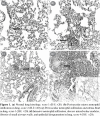Effect of oleanolic acid for prevention of acute lung injury and apoptosis
- PMID: 32082922
- PMCID: PMC7018140
- DOI: 10.5606/tgkdc.dergisi.2019.15058
Effect of oleanolic acid for prevention of acute lung injury and apoptosis
Abstract
Background: This study aims to evaluate the efficiency of oleanolic acid on acute lung injury and acute respiratory distress syndrome.
Methods: The study included 70 female Wistar albino rats (weighing 180 to 200 g). We created seven groups, each consisting of 10 rats. Then, we generated acute lung injuries by intra-tracheal peroxynitrite injection in every group except for the control group. We investigated the effect of oleanolic acid. For this purpose, we measured the levels of malondialdehyde, interleukin 1 beta, interleukin 4, interleukin 10 and tumor necrosis factor alpha in the collected blood samples from the rats. In addition, we examined the lung tissue samples histopathologically and assessed the rate of apoptosis.
Results: Peroxynitrite injected groups at 24 and 48 h showed a statistically significant increase in interleukin 1 beta, tumor necrosis factor alpha, interleukin 4, interleukin 10 and malondialdehyde levels, which are accepted as mediators of the inflammatory process, compared to the control group. When peroxynitrite injected groups at 24 and 48 h were compared to the treatment groups of the same hour, a statistically significant decrease was detected. According to histopathological examination, peroxynitrite injected groups at 24 and 48 h showed a significant increase of tissue injury scores compared to the control group. However, the groups that were treated with oleanolic acid showed a significant decrease compared to the peroxynitrite groups (p<0.001 for tumor necrosis factor alpha and apoptosis results at 48 h).
Conclusion: In this study, we confirmed that oleanolic acid can be an effective agent for the prevention of acute lung injury generated via peroxynitrite.
Keywords: Acute lung injury; acute respiratory distress syndrome; oleanolic acid; peroxynitrite.
Copyright © 2019, Turkish Society of Cardiovascular Surgery.
Conflict of interest statement
Conflict of Interest: The authors declared no conflicts of interest with respect to the authorship and/or publication of this article.
Figures



Similar articles
-
Efficiency of lornoxicam in lung and trachea injury caused by peroxynitrite.Pulm Pharmacol Ther. 2008;21(1):201-7. doi: 10.1016/j.pupt.2007.02.005. Epub 2007 Mar 12. Pulm Pharmacol Ther. 2008. PMID: 17467319
-
Protective effects of erythropoietin against acute lung injury in a rat model of acute necrotizing pancreatitis.World J Gastroenterol. 2007 Dec 14;13(46):6172-82. doi: 10.3748/wjg.v13.i46.6172. World J Gastroenterol. 2007. PMID: 18069756 Free PMC article.
-
Budesonide Attenuates Ventilator-induced Lung Injury in a Rat Model of Inflammatory Acute Respiratory Distress Syndrome.Arch Med Res. 2016 May;47(4):275-84. doi: 10.1016/j.arcmed.2016.07.012. Arch Med Res. 2016. PMID: 27664487
-
The protective effect of oleanolic acid on NMDA-induced MLE-12 cells apoptosis and lung injury in mice by activating SIRT1 and reducing NF-κB acetylation.Int Immunopharmacol. 2019 May;70:520-529. doi: 10.1016/j.intimp.2019.03.018. Epub 2019 Mar 19. Int Immunopharmacol. 2019. PMID: 30901738
-
Parecoxib reduced ventilation induced lung injury in acute respiratory distress syndrome.BMC Pharmacol Toxicol. 2017 Mar 29;18(1):25. doi: 10.1186/s40360-017-0131-z. BMC Pharmacol Toxicol. 2017. PMID: 28356130 Free PMC article.
Cited by
-
Oleanolic acid and its analogues: promising therapeutics for kidney disease.Chin Med. 2024 May 30;19(1):74. doi: 10.1186/s13020-024-00934-w. Chin Med. 2024. PMID: 38816880 Free PMC article. Review.
References
-
- Özyurt Y, Erkal H, Demirhan R, Arıkan Z. Akut respiratuar distres sendromu (ARDS) Turk Gogus Kalp Dama. 2002;10:126–130.
-
- Altıntaş ND, Topeli İskit A. Akut solunum sıkıntısı sendromu tanısı ve tedavisinde güncel yaklaşımlar. Tüberküloz ve Toraks Dergisi. 2009;57:228–236. - PubMed
-
- Phua J, Badia JR, Adhikari NK, Friedrich JO, Fowler RA, Singh JM, et al. Has mortality from acute respiratory distress syndrome decreased over time. : A systematic review. Am J Respir Crit Care Med. 2009;179:220–227. - PubMed
LinkOut - more resources
Full Text Sources
